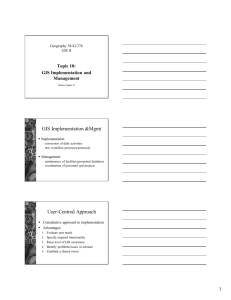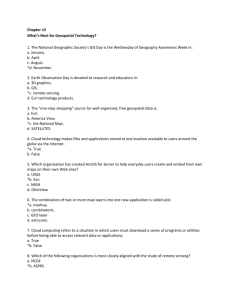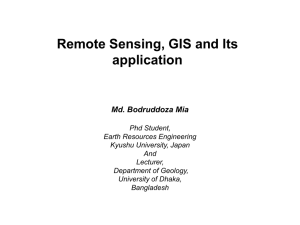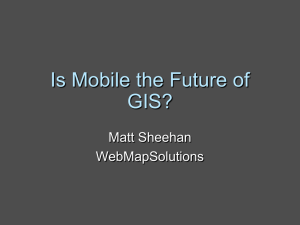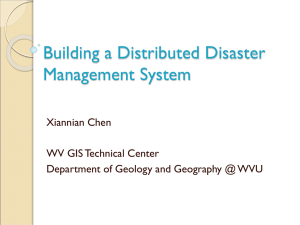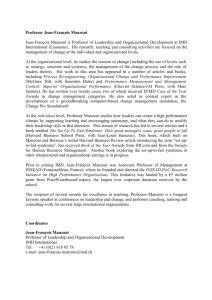Novel Open Source Geospatial analysis for Sustainable
advertisement
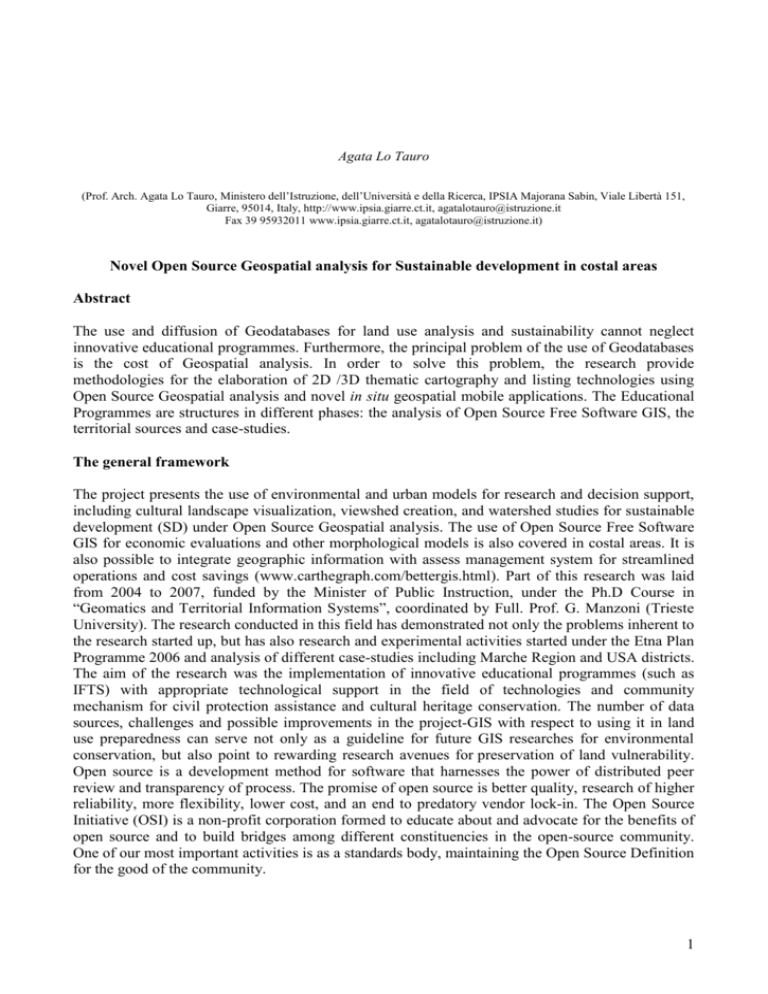
Agata Lo Tauro (Prof. Arch. Agata Lo Tauro, Ministero dell’Istruzione, dell’Università e della Ricerca, IPSIA Majorana Sabin, Viale Libertà 151, Giarre, 95014, Italy, http://www.ipsia.giarre.ct.it, agatalotauro@istruzione.it Fax 39 95932011 www.ipsia.giarre.ct.it, agatalotauro@istruzione.it) Novel Open Source Geospatial analysis for Sustainable development in costal areas Abstract The use and diffusion of Geodatabases for land use analysis and sustainability cannot neglect innovative educational programmes. Furthermore, the principal problem of the use of Geodatabases is the cost of Geospatial analysis. In order to solve this problem, the research provide methodologies for the elaboration of 2D /3D thematic cartography and listing technologies using Open Source Geospatial analysis and novel in situ geospatial mobile applications. The Educational Programmes are structures in different phases: the analysis of Open Source Free Software GIS, the territorial sources and case-studies. The general framework The project presents the use of environmental and urban models for research and decision support, including cultural landscape visualization, viewshed creation, and watershed studies for sustainable development (SD) under Open Source Geospatial analysis. The use of Open Source Free Software GIS for economic evaluations and other morphological models is also covered in costal areas. It is also possible to integrate geographic information with assess management system for streamlined operations and cost savings (www.carthegraph.com/bettergis.html). Part of this research was laid from 2004 to 2007, funded by the Minister of Public Instruction, under the Ph.D Course in “Geomatics and Territorial Information Systems”, coordinated by Full. Prof. G. Manzoni (Trieste University). The research conducted in this field has demonstrated not only the problems inherent to the research started up, but has also research and experimental activities started under the Etna Plan Programme 2006 and analysis of different case-studies including Marche Region and USA districts. The aim of the research was the implementation of innovative educational programmes (such as IFTS) with appropriate technological support in the field of technologies and community mechanism for civil protection assistance and cultural heritage conservation. The number of data sources, challenges and possible improvements in the project-GIS with respect to using it in land use preparedness can serve not only as a guideline for future GIS researches for environmental conservation, but also point to rewarding research avenues for preservation of land vulnerability. Open source is a development method for software that harnesses the power of distributed peer review and transparency of process. The promise of open source is better quality, research of higher reliability, more flexibility, lower cost, and an end to predatory vendor lock-in. The Open Source Initiative (OSI) is a non-profit corporation formed to educate about and advocate for the benefits of open source and to build bridges among different constituencies in the open-source community. One of our most important activities is as a standards body, maintaining the Open Source Definition for the good of the community. 1 The Open Source Initiative Approved License trademark and program creates a nexus of trust around which developers, users, corporations and governments can organize open-source cooperation” (http://www.opensource.org/). It is an area of research that has been used for at least two decades as part of the Institute University of Liverpool, The University Research & Policy Evaluation Regional Research Laboratory, Geographic Information Systems Training Courses under GIS-Courses such as “Introduction to GIS with Arc/Info” and Utilising Ordnance Survey Data in Arc/Info” (1995). In 1993 my idea was to implement and research open-source softwares exploring topics ranging from map production workflows, cartographic geoprocessing, and thematic mapping to specific techniques for producing 3D thematic maps under the COMET Programme. Back in the 2001s, Paul Ramsey espoused the idea of working with open-source geospatial software and experimented with PostGIS as part of his company programme. “Today PostGIS is used globally by organisations differing in scale from graduate research project and community mapping to DigitalGlobe and NASA. Back in the 2005th Full Prof. G. Gallo, were developing Geographic Information Systems Training Courses at the University of Catania, Department of Mathematics and Informatics, with the introduction to Open Source Free Software GIS, in order to meet prerequisites for graduate programs. My idea is now to extend this educational project in the field of Open Source Geospatial analysis with the support of innovative topographic survey and 2D/3D mapping, in situ spectroscopy, innovative MMS combined with thermographic imaging (and laser scanning, VRS, RS, real-time GIS, Web-GIS, novel telecommunication applications, robotics, ICT and Earth Observing mission on reinforcing new sustainable development strategies. “In the frame of Project MONITOR (www.monitorproject.com) of the Galileo Joint, Undertaking Second Call, GEONETLAB, University of Trieste” the Innovative Educational Programmes may involve “experiment on GNSS real time positioning and NMEA transmission via GPRS to a Local Control Centre, by using various kind of almost wearable or pocket PCs and Smartphone as well as of the DGPS/INS GEONETLAB technologies” (Manzoni, G. 2008). NURC, a NATO research centre with a focus on the military maritime environment and the Centro Santa Teresa (CNR and ENEA), involved on marine environmental studies, are implementing research on ‘Rapid Environmental Assessment’. Co-sponsors of this cultural hevent include the Istituto Idrografico della Marina, Genova, Italy, Andrija Mohorovicic Geophysical Institute, Zagreb, Croatia, the Office of Naval Research Global, USA, Consiglio Nazionale delle Ricerche CNR-ISMAR, La Spezia, Italy, the Ente per le Nuove Tecnologie, l’Energia e l’Ambiente ENEACentro Ricerche Ambiente Marino, La Spezia, Italy and Fondazione Cassa di Risparmio, La Spezia, Italy. A wealth of new RS applications has been developed over the last three years using data from ALOS’ three onboard instruments under ESA Research Programmes. Based on a cooperative agreement, ESA has been delivering data from ALOS – Japan's four-tonne Earth Observation satellite – to users across Europe and Africa since its launch three years ago. ESA’s efforts have been recognised by the Japan Aerospace Exploration Agency with an award of appreciation. The agreement between the two space agencies puts ESA in charge of the ALOS European Data Node (ADEN), delivering the satellite’s data to scientific and operational users across Europe and Africa. Within the ADEN network, ESA, JAXA and other partners cooperate to produce a wide range of environmental datasets. Applications include the domains of forestry, global carbon monitoring, oceanography, sea-ice monitoring, agriculture and vegetation monitoring, topography and disaster mitigation (www.esa.int). The didactic activities for high schools, SMEs and post graduate courses (such as International Master Courses) are planned to be structured in different phases: the analysis of the project GIS, the analysis of OS technologies with RS analysis and the case-study with the support of internet search. The e.learning technologies for didactic activities will guarantee to all researchers, 2 experts, professors and students the accurate dissemination of information with internet and intranet systems without missing data. Distance Education Programmes are especially interested in applicants with the expertise to teach undergraduate and graduate classes online using proprietary Web-based educational delivery software (such as the WebTycho and INDIRE). This project also marks a milestone in the effort to promote, protect and ensure the full and equal enjoyment of all human rights and fundamental freedom of persons with disabilities, and to promote respect for their inherent dignity (ONU Convention and National Law - NL 5/2/1992, n. 104, NL 28/1/1999, n. 17, NL 21/5/1998, n. 162, NL 12/3/1999, n. 68, DL 10/11/1993, n. 276, Stanca Law, n. 4 9/1/2004, L 6/9/2004) and students who are in very poor conditions. In particular WebTycho is a customized program developed by University of Maryland University College Europe (UMUC) to facilitate course delivery via the World Wide Web. WebTycho works in conjunction with a web browser to provide an interactive classroom experience to more than 88,000 concurrent UMUC students and faculty around the United States and the world. Uses for WebTycho range from complete course delivery at a distance to supplemental enhancement of face-to-face classrooms (http://www.umuc.edu/index.shtml). Data collection and OS Project-GIS At the beginning of my research project I began researching RS raw data and GPS softwares, receivers and programmes needed to elaborate and convert the data for the project-GIS into shapefiles for the use in Open Source Free Software GIS. I also prepared the existing conditions base maps with the support of GIS-Platform of Different Italian Local Institutions. The project team needed to research and include the usual existing condition boundaries, basements, and topographic and cultural end environmental features. Different receivers and PDA were tested, able to access as many as separate signals and collect data with submeter accuracy. Further research of novel algorithms should be implemented in order to improve the geo-referencing system’s performance during GPS outages. Fig. 1 Fig. 2 Fig. 1 MapQuest 4 Mobile uses phone's GPS chip (www.mapquest.com) to locate brownfields and anthropogenic changes, keep track of progress along a route, or simply detect land use changes in order to design effective land and costal management strategies. Fig.2 Interactive Maps for Mobile Screens - MapQuest 4 Mobile uses smaller map images for mobile screens (www.mapquest.com). This allows to plan real time mobile-GIS without waiting for long downloads. Land features date were entered by scan digitizing, manual digitizing, manual keyboard data entry, and by using procedures available with softwares used with the global positioning satellite system (hereinafter GPS). Data conversion, coordinate system reprojection, and drawing cleanup made this 3 task a bit laborious. The combined impacts of change in land use, modifications of topography and implementation of conservation measures are being investigated using Landsat TM (Tematic Mapper) Imagery, photogrammetric data, DEMs and thematic maps combined with thermographic imaging and process-based models for simulation of Regional Landscape Plan analysis. Despite the advances, the processes involved in data fusion are still currently under development as much as at any point in the past decade. This situation is somewhat complicated by the constant introduction of new and different satellite remote sensors. Moreover, many types of different formats and structures continue to hamper this integration. The simulations used different classification methodologies and a stochastic computational approach based on the duality between particles and fields for solving the governing continuity equations by a path sampling method (Mitasova et al., 2002). The study indicates that changes in topography compensate, to certain extent, the negative impacts of land cover change and that the greatest impact of construction will be on the streams outside the disturbed site, in spite of their protection by vegetative buffers. The fact that the spatial range of land use change impacts extends well beyond the affected site requires that the models capture not only the specific processes at the disturbed locations or for given control structures, but that they can simulate the combined effects of spatially distributed landscape changes and control measures at a larger spatial scale. Novel geospatial mobile applications designed specifically for OS GIS users deliver interactive, intelligent maps and images in geo-enabled different format directly to personnel in the field, enabling them to collect and collaborate with geospatial data to respond faster, make better decisions and be more productive. Initiated as a research and development project GIS for innovative technology solutions the research programme support the mission of GNSS applications. The evolution of Real-time Location System (such as microdrome MDA 200) and Location based Service introduce a profound change to the way critical safety application within the field of sustainable land management will be produced and shared. Conclusion Topographic change in the coastal study areas and preserved areas are driven by interaction between human intervention and natural forces. The case-studies uses a temporal sequence of digital elevation data obtained by RS data, real time kinematic GPS, VRS to monitor the changes in morphology. Comparison of land use changes in morphology show complex evolution pattern that includes shoreline rotation, accelerated short term erosion rates and rapid anthropogenic changes. Contrary to the general perception, the highest morphological changes were observed during years with relatively calm deposition activities compared to the years with direct eruption impacts that bears evidence of lava deposition and catastrophic floods in the Etna Park. Also the spatial pattern of long term rates used for coastal management is quite different from the most recent short term rates, indicating a need for continuous monitoring. Both case studies demonstrate that the higher spatial and temporal resolution of terrain data can provide better understanding of some unexpected consequences of development and creates opportunities for adopting more sustainable approaches to natural and urban landscape management. They also illustrate the current capabilities of open source geospatial technology for topographic data processing, analysis, modelling and visualization for SD strategies. The current capacity to acquire such geospatial data currently by far exceeds the capability to analyze and apply the data for improving understanding of dynamic landscapes or for a wide range of decision making tasks. It also highlighted the need for more training and interoperability and the need to improve Telegeomatics, as highlighted by Manzoni, G, (2006) and The Open Geospatial Consortium (OGC) indications and standards for novel geospatial and location based services (http://www.opengeospatial.org/.). With today's safety, environmental, and sustainable design requirements, I will also have a wealth of other robust data that must also be included, as highlighted by Marcia Carrillo and Lucy Kuhns (2009). Researchers in NOAA’s National Geodetic Survey (NGS) have discovered several open source tools and techniques that may be appropriate for 4 the community of scientists, engineers, and other professionals, including: Researchers who require the ability to add or modify processing and analysis algorithms. Small organizations or individuals who would like to utilize RS data, but cannot afford and/or do not need large, commercial software packages. “Nontraditional” RS data users e.g., those with unique processing/analysis needs or who work in other fields with vastly different requirements (www. www.asprs.org). ACKNOWLEDGMENTS Thanks to specialists including Full Prof. Giorgio Manzoni (Trieste University) and Full Prof. G. Gallo (Catania University). Thanks to Fabrizia Buongiorno, INGV (Centre for Research on Remote Sensing at Rome) for providing RS data. A special thanks goes to Leonardo Alestra, TRIMBLE Sicilian Region for his useful input in terms of imagery data and survey. Significant contributions to this paper, in the form of data collection and valuable discussions, were also provided by Roberto Rinaldi (www.flirthermography.com) and CGT Staff (www.cgtsrl.it). The support by “Soprintendenza per i beni culturali e Ambientali”, Sicilian Region (Dott. Geol. S. Fazzina, Dott. Geol. Franco La Fico) is gratefully acknowledged. Thanks to Monika Denburg Director, DE Program UMUC Europe and Dott Geol N. Costa. References Carrillo, M. and Kuhns, L. Data to Design: Good Design Requires Accurate Base Maps. Cadalyst, Integrating Technology for Manufacturing, AEC and GIS, Jan 7, 2009, www.cadalyst.com Giuffrida A. Lo Tauro A. Technologies and community mechanism for civil protection assistance and cultural heritage conservation. CORP 2006 & Geomultimedia06, Sustainable Solution for the Information society – 11th International Conference on Urban Planning and Spatial Development for the Information Society, Vienna Feb. 13-16 2006 (http://www.corp.at/Download/CORP2006_CDRom/archiv/papers2006/CORP2006_GIUFFRIDA. pdf) pp. 249-253 Lo Tauro, A. 2007. The integration of Remote Sensing and GIS to facilitate Environmental and Cultural Resources Management. Ph.D Thesis, Faculty of Informatics and Mathematics, University of Trieste, pp. 1-200. Manzoni, G. Telegeomatica applicata al rischio vulcanico. Atti del Convegno “Il piano Etna, rischio vulcanico versante sud”, Nicolosi, 12 July 2006. Manzoni, G. and MONITOR GEONETLAB team. GALILEO in Civil Engineering in CEI perspectives: a Pilot Project of MONITOR, Geophysical Research Abstracts, Vol. 10, EGU2008-A04723, 2008 SRef-ID: 1607 7962/gra/EGU2008-A-04723 EGU General Assembly, 2008. Mitasova, H. and Neteler, M. GRASS as Open Source Free Software GIS: Accomplishments and Perspectives. Transactions in GIS, 145–154, 2002. Surace, L. 1998, La georeferenziazione delle informazioni territoriali. Bollettino di Geodesia e Scienze Affini dell’Istituto Geografico Militare, 58, pp. 181-234. Villa, B. 2005. Tecniche Innovative di rilievo e rappresentazione dei Beni Culturali, Corso di Aggiornamento SIFET 2005 Websites 1. http://www.architettura.unipa.it/villa/ 2. http://www.demq.unict.it/salvatore.ingrassia/research/ 3. http://www.cgtsrl.it 1. http://www.carthegraph.com/bettergis.html 4. http://www.esa.int 5. http://www.european-waternews.com 6. http://www.flirthermography.com 5 7. http://www.gim-international.com 8. http://www.hydro-international.com/news 8. http://www.marina.difesa.it/idro/index.asp3. 9. http://www.monitorproject.com 10. http://www.opengeospatial.org/ 11. http://www.opensource.org/ 12. http://www.perform.unige.it./ 6

